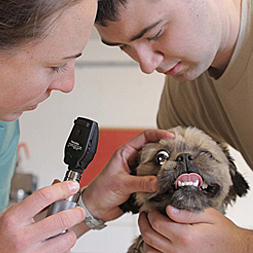I bet you feel as if you are constantly getting reminders or notices from your veterinarian to come in for an exam. And I bet you are often thinking your pet looks and acts just fine, so what is the point?
Well, here’s the point. Much like small children, animals are unable to communicate when something is bothering them. A physical exam is often one of our only ways of determining if there is a disease process going on.
So what actually happens during that quick 5 to 10 minutes that your vet is laying their hands on your pet?
- Eyes: external structures like eyelids, conjunctiva, eyelashes and folds are examined and then the interior of the eye is examined for any ocular diseases along with systemic manifestations like diabetes or high blood pressure.
- Ears: eardrums, middle and outer ear structures are examined for signs of disease. Ears are often a good sentinel for allergic and skin diseases.
- Mouth: teeth, gums and tongue are examined for dental disease, growths, inflammation and any other abnormalities. Bad breath can be a sign of dental disease but can also be illustrative of a systemic disease like kidney dysfunction.
- Skin: veterinarians are looking for parasites, signs of infection or inflammation, loss of hair, changes in pigment of skin or hair and growths or masses.
- Joints: range of motion and palpation can unveil signs of pain, loss of flexibility, increase in laxity, and swelling which can demonstrate injury, arthritis, tumors or other musculoskeletal abnormalities.
- Heart and lungs: Your vet will use a stethoscope to listen to your pet’s heart, focusing on the beat, rate and rhythm and assessing for changes in blood flow, murmurs and/or arrhythmias. They will also listen to the lungs to evaluate air flow patterns and changes in lung sounds across the rib cage.
- Abdominal palpation: This evaluation allows your veterinarian to feel your pet’s abdominal organs (liver, intestines, kidneys, bladder) for abnormalities and check for increases or decreases in size and the presence of fluid or air in the abdomen.
- Rectal: Though not the most fun part of the exam for your pet, for males, it allows the veterinarian to check prostate size and structure, and for all pets the vet can assess anal glands and check for any masses or abnormalities.
So for pets who cannot always communicate when something is bothering them, a veterinary examination can give your vet a lot of information in a short period of time about how your pet’s systems are working and peace of mind to you, the pet parent, that you will catch things as early as you can.
Photo credit: Army Medicine [CC BY 2.0 (http://creativecommons.org/licenses/by/2.0)], via Wikimedia Commons

